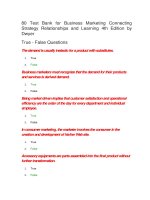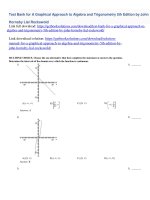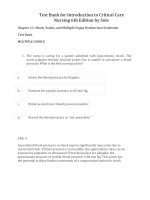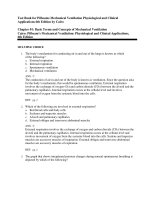Test bank for understanding the essentials of critical care nursing 2nd edition by perrin
Bạn đang xem bản rút gọn của tài liệu. Xem và tải ngay bản đầy đủ của tài liệu tại đây (254.48 KB, 37 trang )
Link download full: />Understanding the Essentials of Critical Care Nursing, 2nd Edition Test Bank
– Perrin
Understanding the Essentials of Critical Care Nursing, 2nd Edition Test Bank –
Perrin
Perrin, Understanding the Essentials of Critical Care Nursing, 2/e
Chapter 9
Question 1
Type: MCSA
A patient arrives in the emergency department with a flail chest after a motor
vehicle accident (MVA) in which the patient’s chest hit the steering wheel. The
nurse realizes this injury is due to:
1.
2.
3.
4.
Blunt trauma from internal forces caused by acceleration
Blunt trauma from external forces caused by deceleration
Penetrating trauma from external forces caused by deceleration
Penetrating trauma from internal forces caused by acceleration
Correct Answer: 2
Rationale 1: Internal forces refer to stress or strain created within the body, not
from outside forces. Acceleration forces are when the increasing speed hits
someone who is stationary, such as a car hitting a person crossing the street.
Rationale 2: Blunt trauma leaves the skin intact and damage to underlying tissue,
such as broken ribs. External forces are created by the mass of the object and
velocity of movement outside the body and the weight of the person being pushed
forward after the car hit something. Deceleration is the force that stops or
decreases the velocity of the moving victim, such as the chest hitting the steering
wheel.
Rationale 3: Penetrating wounds have an open wound and flail chests are intact at
the skin level.
Rationale 4: Penetrating wounds have an open wound and flail chests are intact at
the skin level. Internal forces refer to stress or strain created within the body, not
from outside forces.
Global Rationale:
Cognitive Level: Analyzing
Client Need: Physiological Integrity
Client Need Sub: Reduction of Risk Potential
Nursing/Integrated Concepts: Nursing Process: Assessment
Learning Outcome: 9-1: Compare and contrast blunt and penetrating trauma.
Question 2
Type: MCSA
Which patient sustained an open traumatic injury? A patient with:
1. A closed hip fracture that was caused by a fall
2. A gun shot wound without penetration of the bullet due to the bullet-proof
vest
3. Near-drowning after falling through a frozen lake
4. Burns over 30% of the body from a house fire
Correct Answer: 4
Rationale 1: This is an example of blunt trauma in which the skin is not broken,
but underlying tissue is damaged.
Rationale 2: This is an example of blunt trauma in which the skin is not broken,
but underlying tissue is damaged.
Rationale 3: This is an example of blunt trauma in which the skin is not broken,
but underlying tissue is damaged.
Rationale 4: Burns over 30% of the body from a house fire is an example of an
open or penetrating wound in which the skin does not remain intact.
Global Rationale:
Cognitive Level: Analyzing
Client Need: Physiological Integrity
Client Need Sub: Reduction of Risk Potential
Nursing/Integrated Concepts: Nursing Process: Assessment
Learning Outcome: 9-1: Compare and contrast blunt and penetrating trauma.
Question 3
Type: MCMA
When performing a quick assessment to identify life-threatening problems in a
trauma patient, the nurse would include which assessments under the D–Disability
section?
Note: Credit will be given only if all correct choices and no incorrect choices are
selected.
Standard Text: Select all that apply.
1. Ability to respond to painful stimuli
2.
3.
4.
5.
Vital signs
Ability to respond to verbal command
Level of consciousness or unconsciousness
Oxygen saturation levels
Correct Answer: 1,3,4
Rationale 1: This is assessed under the disability part of the primary assessment.
Rationale 2: Vital signs are classified under F–Full set of vital signs.
Rationale 3: This is assessed under the disability part of the primary assessment.
Rationale 4: This is assessed under the disability part of the primary assessment.
Rationale 5: Oxygen levels are covered under C–Circulation of the primary
assessment steps.
Global Rationale:
Cognitive Level: Applying
Client Need: Physiological Integrity
Client Need Sub: Reduction of Risk Potential
Nursing/Integrated Concepts: Nursing Process: Assessment
Learning Outcome: 9-2: Describe elements of the primary and secondary
assessments.
Question 4
Type: MCSA
What activities would the nurse implement under the A section of assessment
priorities when admitting a trauma patient with a suspected spinal cord injury?
1.
2.
3.
4.
Using a manual ventilation bag
Applying heated blankets
Using the jaw thrust maneuver
Assessing for history of asthma
Correct Answer: 3
Rationale 1: This action would be seen in step B–Breathing.
Rationale 2: This action would be seen in step E–Environment/exposure.
Rationale 3: Airway is covered under the A section. Maintaining an open airway
is the first priority. With a fracture or trauma to the neck, respirations may be
altered or prevented by bone or tissue misalignment. The jaw thrust maneuver is
the correct way to open the airway for a cervical spine injury.
Rationale 4: This action is performed in step H–Head-to-toe assessment/medical
history.
Global Rationale:
Cognitive Level: Applying
Client Need: Physiological Integrity
Client Need Sub: Reduction of Risk Potential
Nursing/Integrated Concepts: Nursing Process: Implementation
Learning Outcome: 9-2: Describe elements of the primary and secondary
assessments.
Question 5
Type: MCMA
Which risk factors could lead to the development of airway failure if not
recognized while assessing the airway of a trauma patient?
Note: Credit will be given only if all correct choices and no incorrect choices are
selected.
Standard Text: Select all that apply.
1.
2.
3.
4.
5.
Chest wall injury
Displacement of the trachea (tracheal shift)
Aspiration of gastric contents
Foreign object occlusion of the throat/mouth
Swelling of soft tissue in the throat
Correct Answer: 2,3,4,5
Rationale 1: The chest wall injury would be a breathing survey assessment
because it focuses on thoracic trauma and the ability to ventilate and not obstruct
the airway itself.
Rationale 2: This can obstruct the airflow into or out of the lungs and cause airway
failure.
Rationale 3: This can obstruct the airflow into or out of the lungs and cause airway
failure.
Rationale 4: This can obstruct the airflow into or out of the lungs and cause airway
failure.
Rationale 5: This can obstruct the airflow into or out of the lungs and cause airway
failure.
Global Rationale:
Cognitive Level: Analyzing
Client Need: Physiological Integrity
Client Need Sub: Reduction of Risk Potential
Nursing/Integrated Concepts: Nursing Process: Assessment
Learning Outcome: 9-4: Discuss airway problems that may develop in a trauma
patient.
Question 6
Type: MCSA
Which nursing assessment would have highest priority for early airway
management of a trauma patient?
1.
2.
3.
4.
Ask the patient to state his name.
Assess increasing intracranial pressure (ICP) with facial fractures.
Prepare for emergency tracheostomy.
Perform a computerized tomography (CT) scan of tissues of the neck.
Correct Answer: 1
Rationale 1: If the patient can state his name audibly then the airway is patent.
Rationale 2: ICP monitoring might be needed but it is not the first priority of the
nurse for airway issues.
Rationale 3: Emergency tracheostomy might be needed but it is still a second
action only if needed.
Rationale 4: CT scanning might be needed but it is not the first priority of the
nurse for airway issues.
Global Rationale:
Cognitive Level: Analyzing
Client Need: Physiological Integrity
Client Need Sub: Reduction of Risk Potential
Nursing/Integrated Concepts: Nursing Process: Assessment
Learning Outcome: 9-4: Discuss airway problems that may develop in a trauma
patient.
Question 7
Type: MCSA
Which assessment finding indicates that a trauma patient is having problems with
breathing rather than difficulty maintaining an airway?
1.
2.
3.
4.
Pain with swallowing, coughing, or hemoptysis
Chest pain on inspiration
Popping sound (crepitus) in the throat when touching the skin by the trachea
Hoarseness when talking
Correct Answer: 2
Rationale 1: Each of these symptoms is an example of an airway maintenance
issue that can contribute to decreased airflow through the throat.
Rationale 2: Chest pain is a breathing issue and not an airway problem.
Rationale 3: Crepitus is noted with laryngeal fractures where air is escaping into
the subcutaneous tissue.
Rationale 4: This is an example of an airway maintenance issue that can contribute
to decreased airflow through the throat.
Global Rationale:
Cognitive Level: Analyzing
Client Need: Physiological Integrity
Client Need Sub: Reduction of Risk Potential
Nursing/Integrated Concepts: Nursing Process: Assessment
Learning Outcome: 9-4: Discuss airway problems that may develop in a trauma
patient.
Question 8
Type: MCMA
Which will the nurse assess when evaluating breathing in a patient suspected of
having a thoracic trauma?
Note: Credit will be given only if all correct choices and no incorrect choices are
selected.
Standard Text: Select all that apply.
1.
2.
3.
4.
5.
Jugular vein distention
Symmetry of chest movement bilaterally
Chest movements that rise and fall with breathing effort
Respiratory rate, pattern, and effort
Peripheral skin coloring
Correct Answer: 1,2,3,4
Rationale 1: Jugular vein distention will increase when chest pressure rises with
displacement or fluid buildup in which the heart must work harder to circulate the
blood and perfuse tissues that are hypoxic.
Rationale 2: Chest movement symmetry will be assessed in the patient with
thoracic trauma.
Rationale 3: Chest movements that rise and fall with breathing will be assessed in
the patient with thoracic trauma.
Rationale 4: Respiratory rate, pattern, and effort will be assessed in the patient
with thoracic trauma.
Rationale 5: Skin coloring is a circulation issue, not a breathing issue.
Global Rationale:
Cognitive Level: Applying
Client Need: Physiological Integrity
Client Need Sub: Reduction of Risk Potential
Nursing/Integrated Concepts: Nursing Process: Assessment
Learning Outcome: 9-5: Compare and contrast manifestations and management
of various types of thoracic trauma.
Question 9
Type: MCSA
What will the nurse expect to assess in a patient with a tension pneumothorax?
1.
2.
3.
4.
Tracheal deviation to the unaffected side
Bilateral equal chest movement
Decreased muscular effort by chest muscles
Decreasing central venous pressure (CVP)
Correct Answer: 1
Rationale 1: As air accumulates on the pleural space with no place to escape, the
affected lung collapses and the resulting increase on intrathoracic pressure puts
pressure on the trachea, which causes displacement to the unaffected side.
Rationale 2: Normal breathing is bilaterally equal. In a tension pneumothorax, one
or more areas of the lung tissue collapses and does not expand, therefore limiting
the chest movement on that side. Therefore, the movement is bilaterally unequal.
Rationale 3: Increased muscle effort will be the response to decreasing lung
activity. Extra muscles of the chest are called into place to try to increase the effort
to move the air within the lung tissues.
Rationale 4: The CVP will increase to try to compensate for decreased pulmonary
perfusion from a decrease in the surface area for oxygen to be exchanged.
Global Rationale:
Cognitive Level: Analyzing
Client Need: Physiological Integrity
Client Need Sub: Physiological Adaptation
Nursing/Integrated Concepts: Nursing Process: Assessment
Learning Outcome: 9-5: Compare and contrast manifestations and management
of various types of thoracic trauma.
Question 10
Type: MCMA
Which goals are appropriate for a patient with a traumatic injury and an ineffective
breathing pattern?
Note: Credit will be given only if all correct choices and no incorrect choices are
selected.
Standard Text: Select all that apply.
1.
2.
3.
4.
5.
Provide oxygen 100% therapy through a nonrebreather mask.
Restore the normal breathing pattern.
Maintain a calm environment to decrease oxygen demands.
Prevent sepsis
Maintain balanced hydration
Correct Answer: 1,2,4
Rationale 1: This will maximize available oxygen and allow the least respiratory
effort to increase perfusion to the greatest number of alveolar areas.
Rationale 2: This will maximize available oxygen and allow the least respiratory
effort to increase perfusion to the greatest number of alveolar areas.
Rationale 3: Although remaining calm will decrease the oxygen demand, this is
not likely to occur when breathing difficulties create both physical and emotional
stress. Sedation may be needed if ventilation is in use and the patient is fighting the
ventilator.
Rationale 4: Preventing infection will allow the least respiratory effort to increase
perfusion in the greatest number of alveolar areas.
Rationale 5: Although keeping the lung tissue moist is the ideal way to improve
cellular tissue exchange, it will not help if the problem is ineffective breathing. The
muscle effort or surface available to exchange is the problem that needs correction.
Global Rationale:
Cognitive Level: Analyzing
Client Need: Physiological Integrity
Client Need Sub: Physiological Adaptation
Nursing/Integrated Concepts: Nursing Process: Planning
Learning Outcome: 9-5: Compare and contrast manifestations and management
of various types of thoracic trauma.
Question 11
Type: MCMA
In the patient with thoracic trauma, what would the nurse identify as potential
problems?
Note: Credit will be given only if all correct choices and no incorrect choices are
selected.
Standard Text: Select all that apply.
1. Pleural effusion
2.
3.
4.
5.
Subcutaneous emphysema
Tracheal shift
Vertebral column injury
Bladder rupture
Correct Answer: 1,2,3,4
Rationale 1: Tears in lung tissue and fluid accumulation in the pleural space will
decrease the gas exchange at the capillary level and/or at the airflow through the
trachea.
Rationale 2: Tears in lung tissue will decrease the gas exchange at the capillary
level and/or at the airflow through the trachea.
Rationale 3: Displacement of underlying structures will decrease the gas exchange
at the capillary level and/or at the airflow through the trachea.
Rationale 4: Displacement of underlying structures will decrease the gas exchange
at the capillary level and/or at the airflow through the trachea.
Rationale 5: Bladder rupture would occur as a potential complication with
abdominal trauma and not as likely with a thoracic trauma.
Global Rationale:
Cognitive Level: Analyzing
Client Need: Physiological Integrity
Client Need Sub: Reduction of Risk Potential
Nursing/Integrated Concepts: Nursing Process: Planning
Learning Outcome: 9-5: Compare and contrast manifestations and management
of various types of thoracic trauma.
Question 12
Type: MCMA
Immediate interventions for a patient with a sucking chest wound include:
Note: Credit will be given only if all correct choices and no incorrect choices are
selected.
Standard Text: Select all that apply.
1.
2.
3.
4.
5.
Administer pain medication.
Continue to monitor pulse oximetry and respiratory characteristics.
Prepare for emergency intubation.
Prepare the patient for chest tube insertion.
Apply a dressing that is taped on three sides.
Correct Answer: 1,2,4,5
Rationale 1: Pain medication will allow an ease in the breathing effort and reduce
pain on insertion of the chest tube.
Rationale 2: The nurse will continuously monitor pulse oximetry and respiratory
characteristics.
Rationale 3: Emergency intubation may not be required because the patient can
still breathe. The problem is not the effort to inhale or exhale air but to expand the
collapsed lung tissue and prevent pressure buildup in the enclosed lung cavity.
Rationale 4: Chest tubes are used to reinflate lung tissue by creating a negative
pressure.
Rationale 5: A sucking chest wound sucks atmospheric air into the chest cavity
with each breath. Closing off this air will decrease the collapse of lung tissue by
using a dressing that allows air to leave the chest cavity (thus not taping all four
sides) but decreasing the intake of air on inhalation.
Global Rationale:
Cognitive Level: Applying
Client Need: Physiological Integrity
Client Need Sub: Reduction of Risk Potential
Nursing/Integrated Concepts: Nursing Process: Implementation
Learning Outcome: 9-5: Compare and contrast manifestations and management
of various types of thoracic trauma.
Question 13
Type: MCSA
When discussing hemorrhagic shock with a nursing class, which statement by a
student indicates to the nurse educator that additional teaching is required?
1. Blood loss into the abdominal cavity can lead to hypovolemic shock.
2. Septic shock is more common than hemorrhagic shock due to nosocomial
infections.
3. When fluids shift into the interstitial spaces, the loss of vascular fluids can
lead to hypovolemic shock.
4. Hemorrhagic shock symptoms include tachycardia, dyspnea, and
hypotension.
Correct Answer: 2
Rationale 1: This is a true statement and does not need additional teaching.
Rationale 2: Septic shock is not more common than hemorrhagic shock.
Hemorrhage is the most common cause for shock.
Rationale 3: This is a true statement and does not need additional teaching.
Rationale 4: This is a true statement and does not need additional teaching.
Global Rationale:
Cognitive Level: Analyzing
Client Need: Health Promotion and Maintenance
Client Need Sub:
Nursing/Integrated Concepts: Nursing Process: Evaluation
Learning Outcome: 9-6: Recognize the manifestations of hemorrhagic shock and
plan management strategies.
Question 14
Type: MCSA
When managing shock, which statement would be incorrect when comparing the
level or classification of shock to the drug treatment?
1.
2.
3.
4.
Class I–treated with blood products
Class II–treated with isotonic fluids
Class III–treated with isotonic fluids and blood products
Class IV–treated with blood and fluids
Correct Answer: 1
Rationale 1: Class I–treated with colloid fluid resuscitation is incorrect and should
be treated with isotonic fluids.
Rationale 2: This is the correct treatment for Class II shock.
Rationale 3: This is the correct treatment for Class III shock.
Rationale 4: This is the correct treatment for Class IV shock.
Global Rationale:
Cognitive Level: Analyzing
Client Need: Physiological Integrity
Client Need Sub: Pharmacological and Parenteral Therapies
Nursing/Integrated Concepts: Nursing Process: Implementation
Learning Outcome: 9-6: Recognize the manifestations of hemorrhagic shock and
plan management strategies.
Question 15
Type: MCMA
During the assessment of a patient with a suspected cardiac tamponade, the nurse
should monitor for the development of:
Note: Credit will be given only if all correct choices and no incorrect choices are
selected.
Standard Text: Select all that apply.
1.
2.
3.
4.
Pulsus paradoxus
Muffled heart sounds
Hypotension
Flat jugular veins
Correct Answer: 1,2,3
Rationale 1: This is a symptom of cardiac tamponade.
Rationale 2: This is a symptom of cardiac tamponade.
Rationale 3: This is a symptom of cardiac tamponade.
Rationale 4: Jugular vein distention would increase, not decrease, with the
increasing backup of blood and the decreasing contractility from the limited
motion of the ventricles as fluid/blood builds up within the sac, limiting its ability
to move.
Global Rationale:
Cognitive Level: Analyzing
Client Need: Physiological Integrity
Client Need Sub: Physiological Adaptation
Nursing/Integrated Concepts: Nursing Process: Assessment
Learning Outcome: 9-7: Explain cardiac tamponade.
Question 16
Type: MCSA
The nurse identifies that a patient is at risk for the development of reoccurring
cardiac tamponade when:
1.
2.
3.
4.
Fluid or blood continues to accumulate in the pericardial sac.
The cause of the tamponade was persistent hypertension.
Treatment by needle aspiration of the fluid in the sac is performed.
A pericardial window is surgically created.
Correct Answer: 1
Rationale 1: Unless immediate treatment is initiated, the tamponade will reoccur.
Rationale 2: Cardiac tamponade is not caused by hypertension.
Rationale 3: This is a treatment to repair cardiac tamponade.
Rationale 4: This is a treatment to repair cardiac tamponade.
Global Rationale:
Cognitive Level: Analyzing
Client Need: Physiological Integrity
Client Need Sub: Reduction of Risk Potential
Nursing/Integrated Concepts: Nursing Process: Assessment
Learning Outcome: 9-7: Explain cardiac tamponade.
Question 17
Type: MCSA
A nurse notes that a patient with a traumatic brain injury is having a rapid decline
in level of consciousness. If the nurse suspects cerebral herniation the most
appropriate intervention would be to:
1. Briefly hyperventilate the patient.
2. Take measures to increase intracranial pressures by Trendelenburg
positioning.
3. Prepare for emergency surgical repair.
4. Contact the family to come say their last words with the patient.
Correct Answer: 1
Rationale 1: Hyperventilating the patient lowers the ICP by lowering the PaCO2
that is causing vasoconstriction of the cerebral blood vessels and reducing cerebral
blood flow.
Rationale 2: This position places the patient at greater risk of permanent damage
from decreased cerebral blood flow.
Rationale 3: Emergency surgery might be needed but hyperventilating the patient
will temporarily allow more time for informed decision making.
Rationale 4: Although this may be a life and death event, the activity that might
reduce this risk can be temporarily avoided by hyperventilation first.
Global Rationale:
Cognitive Level: Applying
Client Need: Physiological Integrity
Client Need Sub: Reduction of Risk Potential
Nursing/Integrated Concepts: Nursing Process: Implementation
Learning Outcome: 9-8: Identify the patient with a spinal cord injury and
describe management of the injury.
Question 18
Type: MCSA
Which goal would receive the highest priority when caring for the patient with a
cervical spine injury?
1.
2.
3.
4.
Relieve muscle spasm pain
Maintain cervical alignment
Support respiratory effort and prevent atelectasis
Promote hypothermia
Correct Answer: 3
Rationale 1: Pain relief is not of the highest priority at this time.
Rationale 2: Cervical alignment is not of the highest priority at this time.
Rationale 3: Due to the risk of airway obstruction and damage to nerves that
stimulate respiratory function, ventilation may need to be controlled or assisted.
Maintaining oxygenation is the priority at this time.
Rationale 4: Promoting hypothermia is not of the highest priority at this time.
Global Rationale:
Cognitive Level: Analyzing
Client Need: Physiological Integrity
Client Need Sub: Reduction of Risk Potential
Nursing/Integrated Concepts: Nursing Process: Planning
Learning Outcome: 9-8: Identify the patient with a spinal cord injury and
describe management of the injury.
Question 19
Type: MCSA
The mother of a patient just admitted with a spinal cord injury is asking if the
patient will be given steroids. What would be an accurate way for the nurse to
explain the role of steroids in treating spinal cord injuries?
1. Steroids will make the patient feel better overall and retain muscle strength
due to its “muscle-bulking” effects.
2. Steroids have few side effects and remove all symptoms while healing the
problem.
3. Steroids can lead to “road-rage and anger outbursts” and therefore are
avoided except under extreme emergencies.
4. Steroids limit spinal cord edema and ischemia if initiated within 3 hours of
the trauma and given for 48 hours.
Correct Answer: 4
Rationale 1: This is not the reason for using steroids in the patient with a spinal
cord injury.
Rationale 2: These drugs do have some major side effects such as hyperglycemia,
hypertension, redistribution of fat pads, and edema, as well as others that can be
life threatening.
Rationale 3: This is not a concern for the patient with a spinal cord injury.
Rationale 4: This is due to the anti-inflammatory effect of steroid therapy and
would be the best response for the nurse to make.
Global Rationale:
Cognitive Level: Applying
Client Need: Physiological Integrity
Client Need Sub: Pharmacological and Parenteral Therapies
Nursing/Integrated Concepts: Nursing Process: Implementation
Learning Outcome: 9-8: Identify the patient with a spinal cord injury and
describe management of the injury.
Question 20
Type: MCMA
The nurse is caring for a patient with a traumatic injury to the abdomen who is
prescribed conservative, non-operative management. Which ongoing assessments
should the nurse include in the plan of care?
Note: Credit will be given only if all correct choices and no incorrect choices are
selected.
Standard Text: Select all that apply.
1.
2.
3.
4.
5.
Hourly vital signs
Assessment of the degree and type of guarding or rigidity
Hourly CVP readings
ECG changes for bradycardia and widening QRS
Widening pulse pressure
Correct Answer: 1,2,3
Rationale 1: This would be done in the patient with a traumatic abdominal injury
to assess for peritonitis.
Rationale 2: This would be done in the patient with a traumatic abdominal injury
to assess for peritonitis.
Rationale 3: This would be done to assess fluid status and the onset of
hypovolemic shock in the patient with a traumatic abdominal injury.
Rationale 4: The ECG will show tachycardia from hypovolemia. Widening QRS
show slowed conduction in the ventricles and would not be a sign of abdominal
distress.
Rationale 5: Widening pulse pressure is not seen in the patient with traumatic
abdominal injury.
Global Rationale:
Cognitive Level: Applying
Client Need: Physiological Integrity
Client Need Sub: Physiological Adaptation
Nursing/Integrated Concepts: Nursing Process: Planning
Learning Outcome: 9-9: Describe elements of an abdominal assessment of the
patient with a traumatic injury. Identify when surgery may be required.
Question 21
Type: MCSA
Under what circumstance would the nurse expect to prepare a patient for surgery
when abdominal trauma has occurred? A patient with:
1.
2.
3.
4.
A suspected splenic injury and who has received 1 unit of blood
A Grade III liver injury with stable vital signs
A contusion to the kidney with a stable H & H
A pelvic fracture with muscle rigidity of the abdominal wall
Correct Answer: 4
Rationale 1: If additional bleeding requires more than 2 units of blood or becomes
unstable, the patient with splenic injury will require surgical repair to stop the
bleeding.
Rationale 2: In a Grade III liver injury, conservative management outweighs the
risks of surgery. If a Grade IV or V injury occurs in the liver, then surgical repair is
called for immediately.
Rationale 3: With a contusion to the kidney bedrest and careful assessment of
renal status is enough for the contusion to resolve with time.
Rationale 4: The patient with a pelvic fracture is exhibiting signs of bladder
rupture by the muscle rigidity. Immediate surgery is required to assess and repair
the damage to internal organs.
Global Rationale:
Cognitive Level: Analyzing
Client Need: Physiological Integrity
Client Need Sub: Reduction of Risk Potential
Nursing/Integrated Concepts: Nursing Process: Planning
Learning Outcome: 9-9: Describe elements of an abdominal assessment of the
patient with a traumatic injury. Identify when surgery may be required.
Question 22
Type: MCSA
Under the F section of the assessment process, in addition to full vital signs, the
family is considered as a part of the treatment process. Which approach to the
family would be most appropriate for the nurse to use?
1. The family gets in the way of acute care management so the nurse should
offer no support until the patient is stable.
2. Ethically the family has a right to support the patient by being at the bedside
during acute care management, including trauma resuscitation.
3. Depending on the family’s awareness of health care management, they have
the privilege to watch the care if they do not get in the way of the care.
4. Because the care during trauma management can be too graphic for family
to witness, the family should not be allowed at the bedside.
Correct Answer: 2
Rationale 1: This is a bias and it has been shown that having family at the bedside
to support the patient will frequently give a better outcome.
Rationale 2: Legally and ethically the family has the right to be with the patient
under all circumstances, including trauma resuscitation. This topic is greatly
debated but the right is still present and often left to the physician to decide if the
family should step out.
Rationale 3: With or without the medical/health care background, the right is still
present and it is not a privilege to be awarded by staff.
Rationale 4: Even if the circumstance is graphic for the family, the right is present
and benefits will be gained by the patient. The focus of care is not the family’s
needs first but the patient’s.
Global Rationale:
Cognitive Level: Analyzing
Client Need: Psychosocial Integrity
Client Need Sub:
Nursing/Integrated Concepts: Nursing Process: Implementation
Learning Outcome: 9-10: Analyze the benefits of family presence during trauma
resuscitation and care.
Question 23
Type: MCMA
What can the nurse do to convey comfort to a trauma patient?









